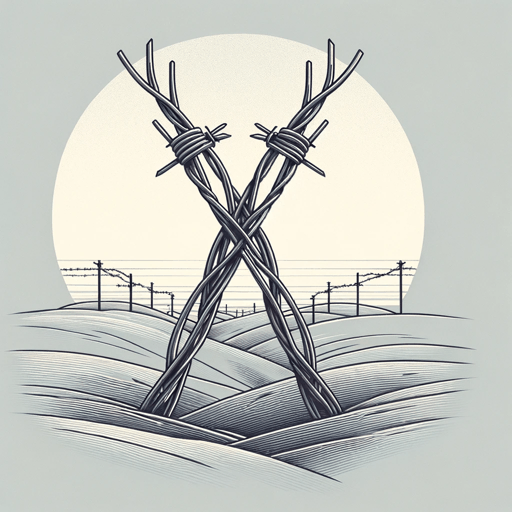53 pages • 1 hour read
John KeeganThe First World War
Nonfiction | Reference/Text Book | Adult | Published in 1999A modern alternative to SparkNotes and CliffsNotes, SuperSummary offers high-quality Study Guides with detailed chapter summaries and analysis of major themes, characters, and more.
Summary and Study Guide
Overview
The First World War (1998) is a work of history by John Keegan, a renowned British scholar of military affairs. The book is regarded as a classic in the field of World War I history, and places a particular emphasis on the military aspects of the war. Indeed, its intense focus on this area has led to criticism for being somewhat reductive, especially in its treatment of political and economic dimensions. Keegan was celebrated for his ability to bring historical issues to life and wrote extensively on the nature of warfare itself as well as on specific conflicts. Apart from The First World War, he is best known for his books Soldiers: A History of Men in Battle (1985) and The Face of Battle (1976).
This study guide is based on the 2000 paperback edition published by Vintage.
Content Warning: This guide includes graphic descriptions of violence and suffering inflicted on both soldiers and civilians. It also discusses death by suicide, colonialism, and the extreme violence that accompanied colonialism, as well as racism and racist attitudes.
Summary
The First World War begins with the argument that World War I was a tragic and unneeded conflict, inflicting incalculable damage on a European civilization that had been enjoying a long period of peace, prosperity, and interdependence. It established a legacy of hyper-nationalism and industrial-scale death that would reappear a generation later with the Second World War, inflicting still more damage and trauma. Keegan finds one of the major causes of the war to be the inflexibility of war plans, which required the movement of millions of troops along railways on extremely precise timetables. Any deviation could interrupt mobilization and leave the army at the mercy of a mobilizing enemy, and the sensitivity of such plans kept them secret even from civilian governments.
This gave militaries an outsized role in political decision-making, so that in the event of a crisis, the threat of enemy mobilization became an all-consuming worry that crowded out appeals to diplomacy. The crisis came at the end of June 1914, with the assassination in Sarajevo of Franz Ferdinand, heir to the throne of Austria-Hungary. His killer was a Serbian nationalist seeking freedom for Serbs still under the Hapsburg empire, who in turn blamed the state of Serbia for the murder. With assurances of support from its ally Germany, Austria-Hungary prepared for war with Serbia, which in turn received support from Russia. Russian mobilization triggered Germany’s Schlieffen Plan, an effort to strike a knockout blow against Russia’s ally France while assuming a defensive position on the Eastern Front. The results were the opposite of intentions, as the offensive into France, which also triggered the entry of Britain into the war, stalled on the outskirts of Paris, while German forces inflicted a catastrophic defeat against Russia at the Battle of Tannenberg.
In the West, the armies dug hundreds of miles of trenches and sought in vain to inflict decisive victories against one another. Offensives could often penetrate the enemy front line, but once they went beyond the limits of their communications and artillery, troops were liable to a counterattack, until the pursuing enemy ran into the exact same thing on the opposite side. Movements of the front were generally quite modest until the last months of the war. Desperate to evict the Germans from French and Belgian territory, the Allies sought in vain to expose vulnerabilities elsewhere, most notoriously with a disastrous landing at Gallipoli in the Dardanelles in April 1915. The following year featured some of the fiercest battles of the war, including Verdun, which the Germans surrounded on three sides in an effort to lure the French army in and wear them down, and the Somme, a British offensive partially intended to relieve the French at Verdun, where 20,000 British soldiers died in a single day.
In 1916 the Russians also mounted the last of their successful offensives under the general Alexei Brusilov. The next year proved a fateful year for many of the combatants. Food shortages in Russia triggered mass riots and a collapse of military discipline, prompting the abdication of the tsar. By the end of the year, the shaky Provisional Government fell to the Bolsheviks under Lenin, who pulled Russia out of the war and proceeded to wage war against Russia’s own domestic enemies. After another failed offensive, many French units refused to fight, and France would not undertake another offensive for an entire year. The Italians suffered a crushing defeat at Caporetto. When the Germans adopted a policy of unrestricted submarine warfare, it prompted the entry of the United States into the war in April 1917. With Russia out of the war, Germany attempted one last series of offensives to settle matters in the West before the Americans could arrive in force, but this stretched the capacities of an army that long endured the privations of a blockade, and as Allied forces prepared to mount an assault on their last line of defenses in France and Belgium, the Germans asked for an armistice. As a result of the war, four empires collapsed—the German, the Austro-Hungarian, the Ottoman, and the Russian—fundamentally transforming global politics and leaving deep scars that would be reopened only 20 years later.

